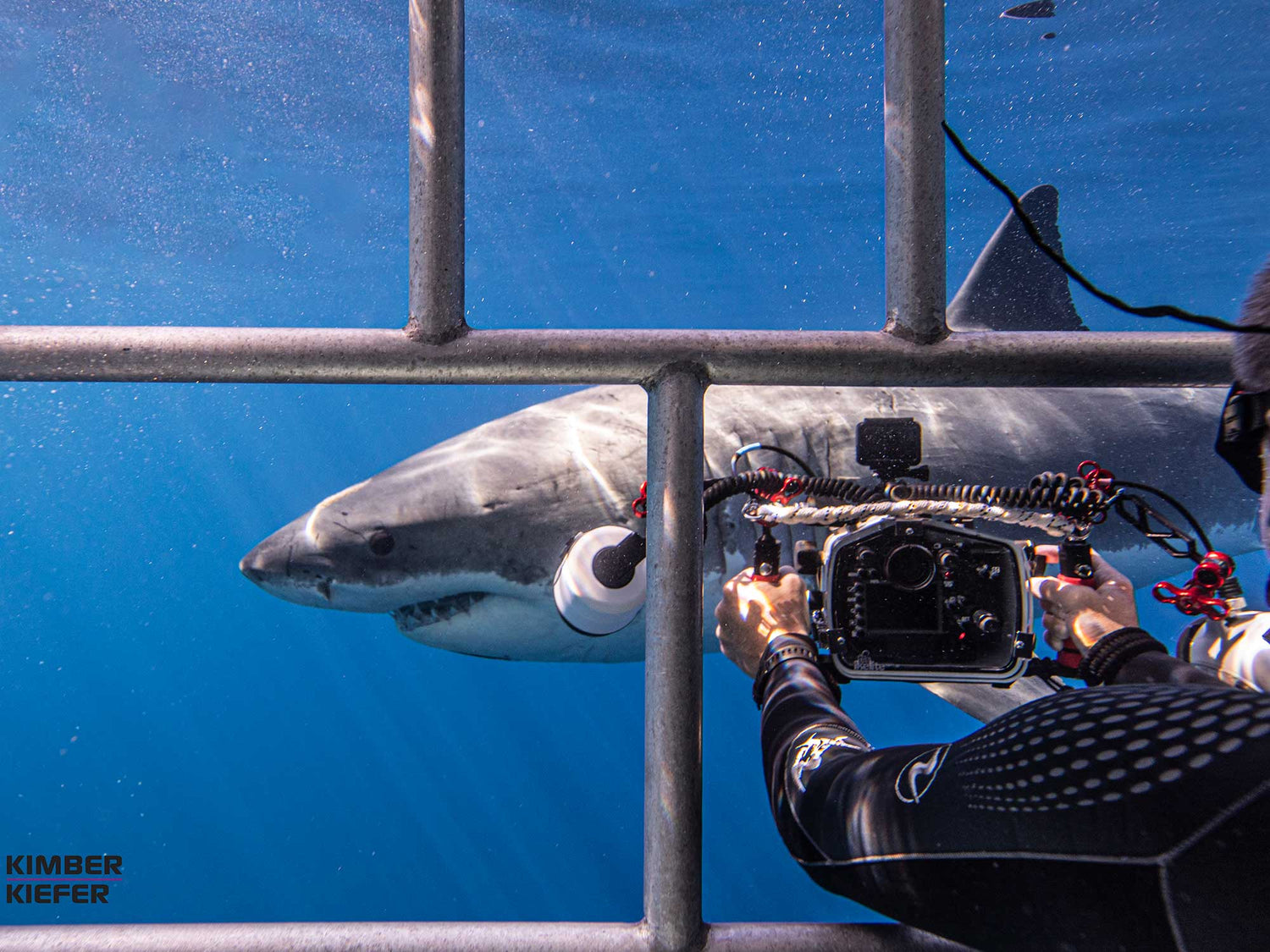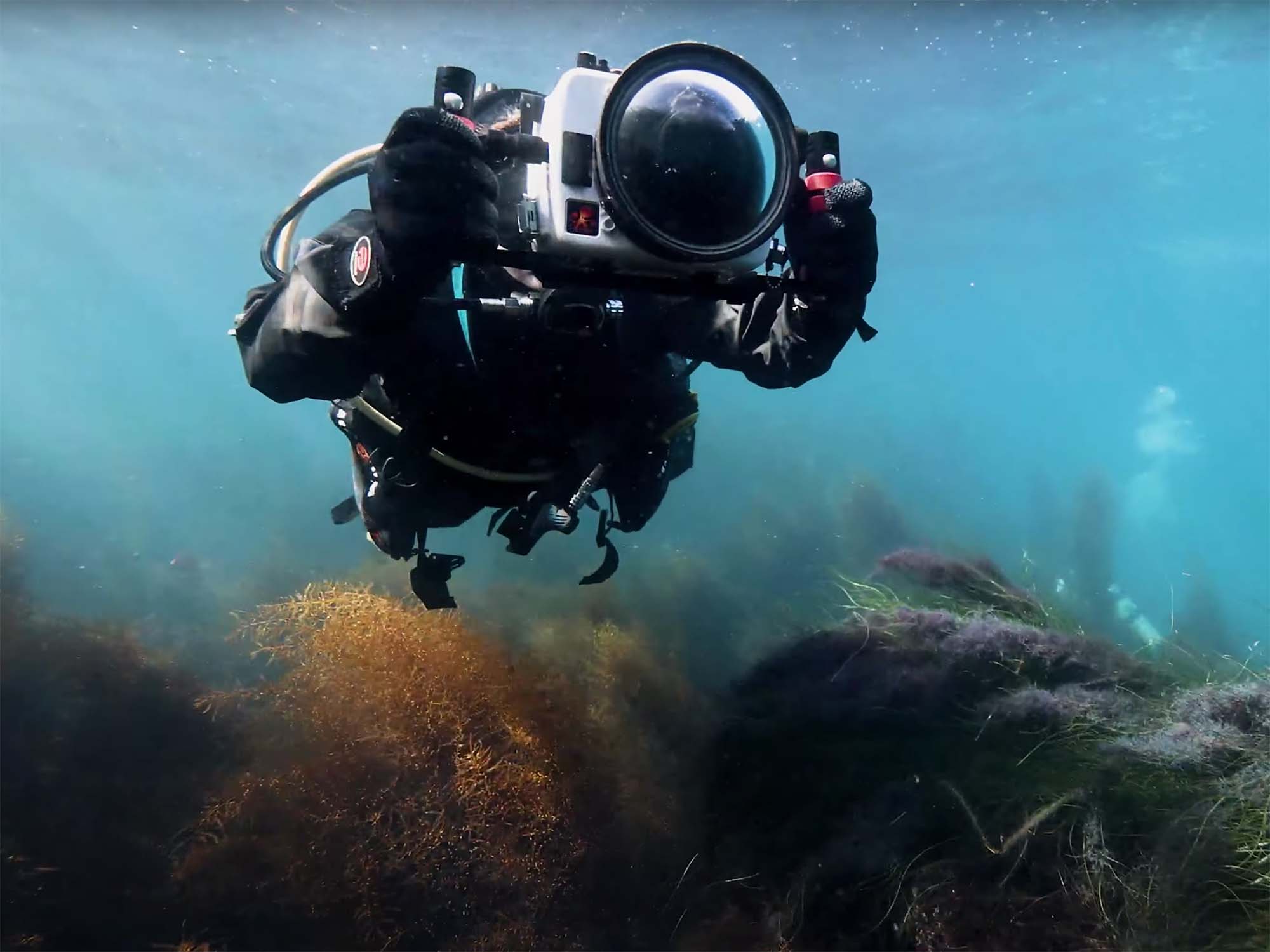By Steve Miller
There was a time, not so long ago, when images and footage of great white sharks were rare, and pure gold! Well-funded expeditions would return after weeks with stories of cold water, low visibility, no sharks, and little to work with.
That was until Guadalupe, a small group of islands off of Mexico, was discovered.
While nothing is guaranteed with wildlife, close encounters with great whites while in a shark cage are relatively easy to experience for divers wishing to image these big beauties. The exact reasons that white sharks congregate in Guadalupe is not fully understood, but they are consistently around and photographers have been reaping the benefits with stunning images for years now. Not only is it safe and fun, but snorkelers can experience the cage as well.

While images of great white sharks are no longer rare, they are still pure gold! © 2022 Ken Kiefer
What to Bring
This is relatively cold water, and you won’t be swimming around much, so most divers will be in a thick wetsuit or a dry suit. Although we have seen very cool images with a 50mm lens (think of tight face and mouth shots) the wide angle zoom will be the first choice for most.

Enter the cage, get your footing, then have your camera passed down to you. It's nice to have a double handle for this. © 2022 Steve Miller
Getting There
Access varies with operators, but you can expect to board a boat just over the border to Mexico on the West Coast. From there, you will have a long run out to Guadalupe on a liveaboard dive boat, just hope for calm seas! Regardless of the trip out, once you arrive in Guadalupe the boat can nestle into calm water for the duration.

Plenty of action takes place on the dive deck, you won't have to swim to the cage. © 2022 Steve Miller
What You’ll Experience
Dive operators have rigged the shark cages we use so that you can access them easily from the stern of the boat. There are deep cages, as well as surface cages. The crew will explain rotation of divers in and out of the water so the everyone gets all of the time they want in the various cages. You will leave your fins behind as it makes it easier to move around in the cage. Most boats will use a surface-supplied air, meaning you use the same second stage regulator as with SCUBA, but now you don't have to carry a tank on your back. This, and the lack of fins, makes for more room to maneuver inside the cage.

The deep and shallow cages offer different vantage points and composition, be sure to try both. The deep cage will submerge for a specific amount of time. Typically you can enter and exit the surface cage whenever you like. Photo © 2022 Steve Miller
Shooting Techniques
Most photographers will be using a wide angle zoom lens. The cages have windows to shoot from that will allow an upward camera angle. When you first enter the cage, get used to the surface supplied second stage regulator, then calculate your mobility (based on how many divers are in the cage) and pick a window to occupy. As you look around, measure the light and pay particular attention to the position of the sun. Keeping in mind that the boat may move around a bit, so the sun will shift. If you can get the sun behind you the sharks will be lit up more than the opposite, which tends to produce a silhouette effect.

Harnessing the position of the sun can create unique opportunities - silhouettes, light rays, or sunlight ripples. © 2022 Ken Kiefer
Lighting
Having a flash will help to “stop the action” by freezing movements with its short duration. A flash will also fill in shadows and provide detail of the sharks body and markings. You have choices as to your exposure, but most of us like a balanced exposure meaning that the flash “fills in” details with soft light. This technique will produce an image that looks like natural light, but with nice detail.

Great whites are well camouflaged by their medium gray colored upper half. When looking towards the deep they will be practically invisible until they seem to appear out of nowhere when sunlight its their bright white bellies. Upward camera angles will provide the best lighting, shooting down at the sharks is problematic. © 2022 Steve Miller
Alternatively, you can expose your background much darker, so that the shark stands out. For flash filling, setting the camera to manual, and determining an aperture that is about one stop darker than the ambient light, then placing your strobes on TTL will produce a good balance. Go about two stops darker (smaller aperture) to darken your background. It is worth noting that if you “flash-fill” the strobes will recycle very quickly because they are using very little power, which is nice for action shots. If you open up your lens (or increase your exposure with ISO or your shutter speed) too much the strobes, when set to TTL, will barely go off as they are sensing that there is so much ambient light already in the scene. If your images have a color caste this is probably the case.

"Say Cheese!" © 2022 Ken Kiefer
But, this is the Pacific, and visibility and conditions can vary widely. In some situations the strobe might not improve your images. If there is a lot of scatter in the water, and low visibility, consider shooting at least some natural light. Strobes are infamous for lighting up debris, including fish scales from a feed, so sometimes pure, natural light can be best. Constant on lights, video lights, etc., can be used in place of a flash for stills, and of course for video.

Much of your time will be spent waiting for the sharks to come close. The wide lens will tend to make them look much smaller and farther away. But, if they come in close enough you will be able to get the whole animal in the frame with good detail. © 2022 Ken Kiefer
Pro Tip
Sometimes these sharks simply swim slow circles when they are not excited by bait and thus don't come in very close. From 15 feet (4.6 meters) away, with a super wide lens, these big sharks can look quite small so being able to zoom in and out helps.
Ready to go?
We can recommend Nautilus Explorer, Solmar V, and Southern Sport liveaboards that operate in Guadalupe as well as other awesome areas for big ocean life including Socorro.

Iconic Ikelite duo Jean Rydberg and John Brigham inside the cage and ready for action. ©2022 Steve Miller
 Ambassador Steve Miller has been a passionate teacher of underwater photography since 1980. In addition to creating aspirational photos as an ambassador, he leads the Ikelite Photo School, conducts equipment testing, contributes content and photography, represents us at dive shows and events, provides one-on-one photo advice to customers, and participates in product research and development. Steve also works as a Guest Experience Manager for the Wakatobi Dive Resort in Indonesia. In his "free" time he busies himself tweaking his very own Backyard Underwater Photo Studio which he's built for testing equipment and techniques. Read more...
Ambassador Steve Miller has been a passionate teacher of underwater photography since 1980. In addition to creating aspirational photos as an ambassador, he leads the Ikelite Photo School, conducts equipment testing, contributes content and photography, represents us at dive shows and events, provides one-on-one photo advice to customers, and participates in product research and development. Steve also works as a Guest Experience Manager for the Wakatobi Dive Resort in Indonesia. In his "free" time he busies himself tweaking his very own Backyard Underwater Photo Studio which he's built for testing equipment and techniques. Read more...
Additional Reading
6 Ways You and Your Kids Can Help Save the Sharks
Techniques for Photographing Sharks
Great White Sharks Underwater Camera Settings and Technique
Crocodiles, Cenotes, and Chinchurro with Ken and Kimber Kiefer













